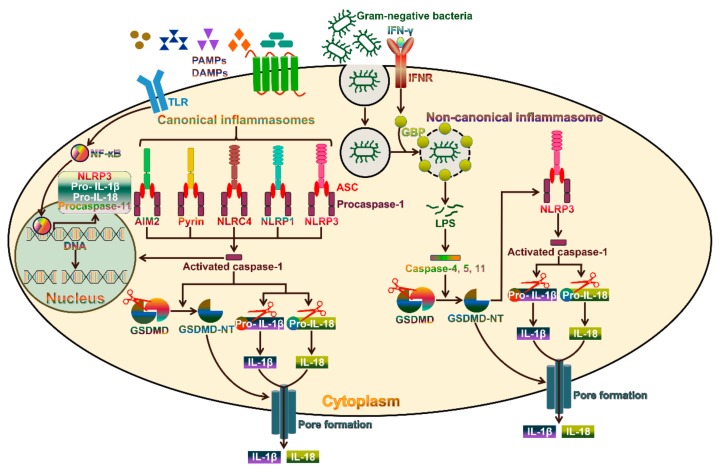Figure 1.
Molecular mechanisms involved in inflammasome activation. Activation of the canonical inflammasomes usually requires two steps. As the first priming step, PAMPs or DAMPs combine with TLRs on the plasma membrane to trigger NF-ĸB-dependent transcription of inflammasome components and their downstream targets, including NLRP3, pro-IL-1β and pro-IL-18. The second step involves the recognition of PAMPs or DAMPs by the inflammasome sensors AIM2, pyrin, NLRC4, NLRP1 and NLRP3. These sensors recruit the adaptor protein ASC and procaspase-1 to form diverse inflammasomes. Once assembled, the inflammasomes act as activating platforms for procaspase-1. Catalytically active caspase-1 converts the inactive pro-IL-1β and pro-IL-18 into their biologically active forms (IL-1β and IL-18). On the other hand, caspase-1 cleaves GSDMD to release an N-terminal pore-forming domain (GSDMD-NT), which migrates toward the plasma membrane and forms membrane pores. The pores facilitate the release of the active IL-1β and IL-18 into the extracellular environment. In addition, caspase-1 activation leads to the cleavage of chromosomal DNA by nuclease activity. The non-canonical inflammasome pathway is specifically activated by Gram-negative bacteria. IFN-γ-induced GBP causes the lysis of Gram-negative bacteria-containing vacuoles, allowing the release of LPS into the cytoplasm. Intracellular bacterial LPS can directly activate caspase-4 and -5 in humans and caspase-11 in mice. These caspases cleave GSDMD to drive pyroptotic cell death. GSDMD-NT activates the NLRP3 inflammasome to promote caspase-1-dependent cytokine maturation. TLR, toll-like receptor; PAMPs, pathogen-associated molecular patterns; DAMPs, damage-associated molecular patterns; IFN-γ, interferon-γ; IFNR, interferon receptor; NF-ĸB, nuclear factor-ĸB; GBP, guanylate-binding protein; ASC, apoptosis-associated speck-like protein containing a caspase recruitment domain; LPS, lipopolysaccharide; GSDMD, gasdermin D; GSDMD-NT, the N-terminal fragment of GSDMD; IL-1β, interleukin-1β; IL-18, interleukin-18.

